There are so many varieties of squash and pumpkins, from small green squash (like Kabocha and Buttercup) to large blue pumpkins (hello Hubbard) – and everything in between.
Most types of winter squash (including pumpkins) are full of nutrients, long-lasting, and delicious – perfect for storing and enjoying all winter long. Varieties of summer squash, on the other hand, are better enjoyed in the moment – picked small and enjoyed right then, at the peak of freshness.
This guide is a work in progress – there are so many kinds of squash! So I’m adding to it all the time. Meanwhile, whether you have a summer squash or a winter squash on hand, here’s where you’ll find a ton of info about all different types of squash – photos, descriptions, and links – about a wide variety of winter squash (including pumpkins) and summer squash.
Now go forth and squashify!
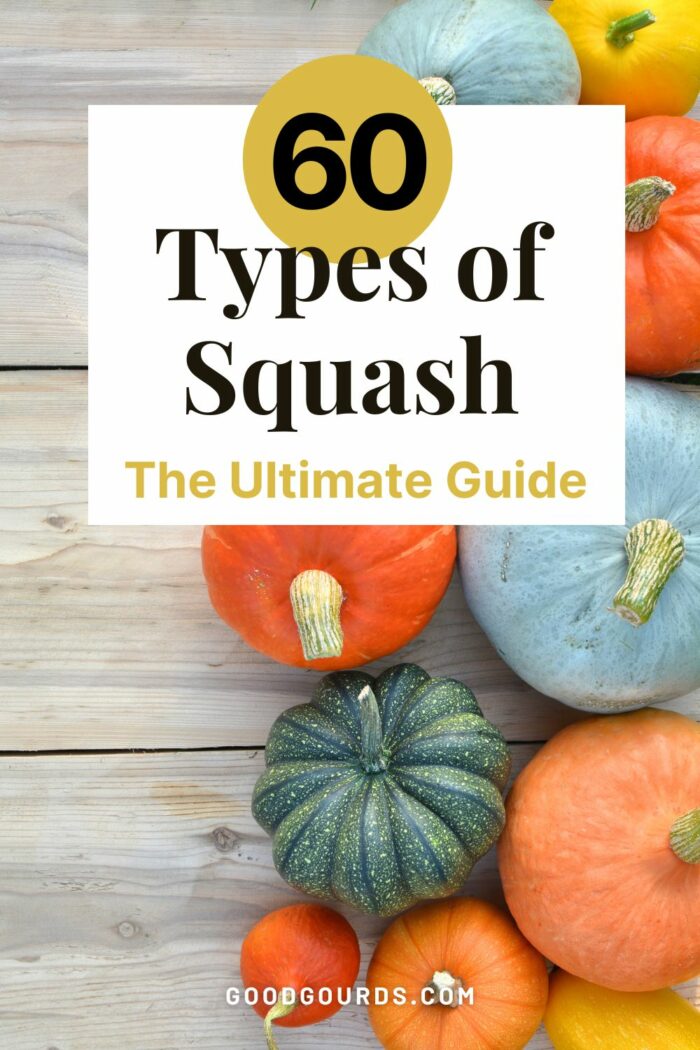
Table of Contents (Types of Squash from A to Z)
- Acorn Squash
- American Tondo Pumpkin
- Autumn Crown Pumpkin
- Baby Blue Hubbard Squash
- Banana Squash
- Big Max Pumpkin
- Black Futsu Pumpkin
- Blue Ballet Squash
- Blue Doll Pumpkin
- Blue Kuri Squash
- Buttercup Squash
- Butternut Squash
- Carnival Squash
- Chayote Squash
- Cinderella Pumpkin (aka Rouge Vif d’Etampes)
- Connecticut Field Pumpkin
- Cousa Squash
- Crookneck Squash
- Cushaw Squash
- Delicata Squash
- Eight Ball Squash
- Flat White Boer Pumpkin
- Galeux d’Eysines Pumpkin
- Grizzly Bear Pumpkin
- Gold Nugget Squash
- Golden Ace Acorn Squash
- Honeynut Squash
- Hubbard Squash
- Jack Be Little Pumpkin
- Jack O’ Lantern Pumpkin
- Jarrahdale Pumpkin
- Jester Squash
- Kabocha Squash
- Kakai Pumpkin
- Long Island Cheese Pumpkin
- Lumina Pumpkin
- Marina Di Chioggia Squash
- Musquee de Provence Pumpkin
- Naples Long Squash
- One Too Many Pumpkin
- Pattypan Squash
- Porcelain Doll Pumpkin
- Queensland Blue Pumpkin
- Red Kabocha Squash
- Red Kuri Squash
- Red Warty Thing Pumpkin
- Silver-Edged Pumpkin
- Spaghetti Squash
- Speckled Hound Pumpkin
- Starry Night Squash
- Stripetti Squash
- Sugar Pie Pumpkin
- Swan White Acorn Squash
- Sweet Dumpling Squash
- Sweet Meat Squash
- Tahitian Butternut Squash
- Triamble Squash
- Tromboncino Squash
- Turks Turban Squash
- White (Ghost) Pumpkin
- Winter Luxury Pumpkin
- Yellow Squash
- Yokohama Squash
- Zephyr Squash
- Zucchini
- Sources
Acorn Squash
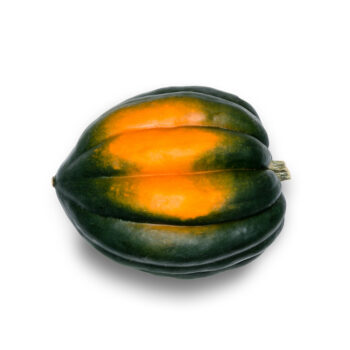
Cucurbita pepo (Acorn Group). This is what many people picture in their when they hear the word “squash,” as Acorn Squash is perhaps the most familiar of all of the winter squash varieties.
Acorn squash is a small to medium, dark green squash with deep ridges that run top to bottom. The inside is deep orange and tastes sweet and nutty when roasted. The texture, like many smaller types of squash, is somewhat dry. Often made simply by cutting in half, scooping out the seeds, brushing with butter, sprinkling on salt, pepper and often brown sugar, then roasting cut-side down. Also known as Table Queen. There are many varieties of Acorn Squash, such as Swan White and Starry Night.
American Tondo Pumpkin

Cucurbita pepo “American Tondo.” This unique and attractive pumpkin features fat lobes of alternating yellow-orange and dark green stripes. Of Italian origin, this pumpkin is medium-to-large (7-12 pounds) in size. This beautiful pumpkin is often grown for its looks and used for ornamental purposes, but it’s also delicious to eat, with a dry texture and sweet flavor. Smaller, less mature pumpkins can be eaten like a summer squash earlier in the season.
Also known as American Tondo Squash, Tonda Padana, and American Tonda.
More about American Tondo Pumpkin
Autumn Crown Pumpkin
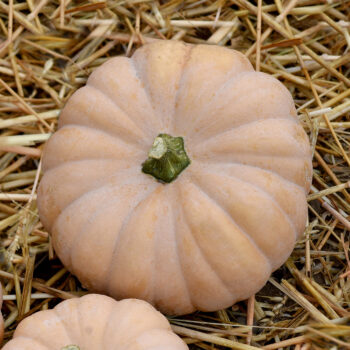
Cucurbita moschata. This small to medium pumpkin weighs in at two to four pounds, with a flat, deeply lobed shape. Autumn Crown is sometimes called the baby cousin of the more well-known Long Island Cheese Pumpkin. The outside is buff in color, with vibrant orange interior. It tastes mild, sweet, creamy, and nutty, and is very similar to Butternut Squash (in fact, it is a hybrid of Butternut Squash and Crown Prince Pumpkin). Also known as Autumn Crown Squash.
Baby Blue Hubbard Squash
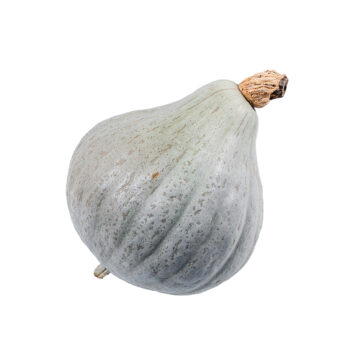
Cucurbita maxima (Hubbard group). Baby Blue Hubbard is a blue, teardrop-shaped, smaller variation of Blue Hubbard. It’s one of the prettiest blue types of squash out there! This attractive winter squash is medium in size, usually about 5-7 pounds. The flesh is deep orange and is sweeter than Blue Hubbard. Relative Hubbard Squash is larger, while Blue Ballet is smaller.
Banana Squash

Cucurbita maxima (Banana Group). Banana Squash are types of squash that grow long and large. How big? Well, around around three feet long and upwards of 30+ pounds, to be exact! When mature, Banana Squash are a salmon pink color, with mild-tasting flesh and an easy-to-remove peel. This heirloom squash, a type of Hubbard, is particularly popular in the southeast United States; in fact, it’s also known as Georgia Candy Roaster Squash. Also available in smaller variations including the especially great tasting Blue Banana.
More about Banana Squash
- Recipe to try: Candy Roaster Squash with Sorghum, Black Walnuts & Cranberries from Southern Living
Big Max Pumpkin
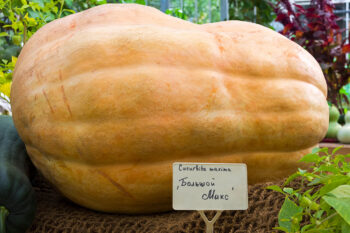
Cucurbita maxima. Big Max Pumpkin is, well, big. HUGE, actually. Pumpkins can be nearly two feet in diameter, and can weigh 100 pounds – or more! One pumpkin makes, as you can imagine, a LOT of pies. Pale orange to bright orange in color with deep orange flesh and considered good for pies and for canning as well. A popular giant pumpkin to grow and show!
Black Futsu Pumpkin

Cucurbita moschata. Lumpy and bumpy and unique in color, Black Futsu ranges from pale orange with a hint of gray to deep matte forest green-black. These types of squash are Japanese heirlooms, and are quite small, weighing in just a pound or two. Its deep orange flesh tastes sweet and nutty, but the best part is that Black Futsu has super thin skin can can be prepared with the skin left on, like delicata squash.
Visually ranges from deeply lobed to unbelievably warty. Known for its long storage time. Also known as Black Futsu Squash.
More About Black Futsu Pumpkin
Blue Ballet Squash
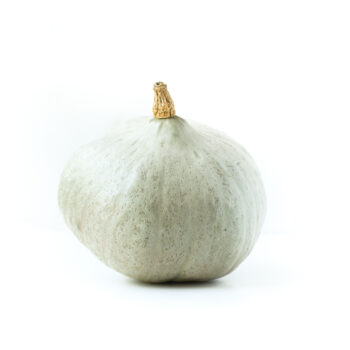
Cucurbita maxima (Hubbard group). Basically a baby Hubbard, this winter squash is teardrop-shaped and medium in size (4-6 pounds) with smooth blue skin. Known for storing well and being relatively easy to grow, Blue Ballet Squash features bright orange flesh that’s smooth and a touch sweeter than its predecessor.
Blue Doll Pumpkin

Cucurbita maxima. With its squat appearance, deeply ribbed lobes, and dusty blue-green hue, Blue Doll Pumpkin is a gorgeous pumpkin for displays. This blocky pumpkin is big – 15-20 pounds in size. Inside, the deep orange flesh is sweet and great for pies and soups. Not sure about blue? Well, there’s a pink version too!
Blue Kuri Squash
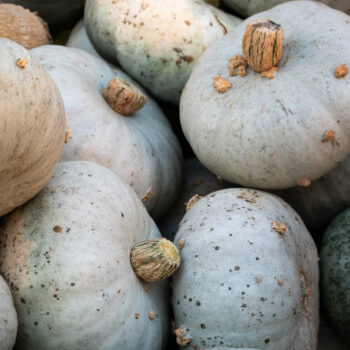
Cucurbita maxima. Blue Kuri is a variety of Kabocha and looks very similar, but sports a pale blue-gray color. Japanese in origin. Small in size (two to three pounds), Blue Kuri’s yellow flesh is described as smooth, creamy, sweet and nutty. Also known as Blue Kabocha, Blue Kuri Kabocha, or Blue Hokkaido.
Buttercup Squash
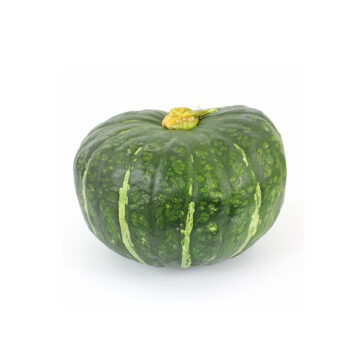
Cucurbita maxima (Buttercup Group). These winter squashes are small, green types of squash with lighter green vertical stripes, a flattened round shape, a corky stem, and a rohnd “button” on the bottom of the squash. Small in size – typically 3 to 5 pounds. The yellow-orange flesh is super sweet, mild, nutty flavor and smooth, creamy, dry texture. Closely related to Turk’s Turban Squash, but very similar in looks to Kabocha Squash. Buttercup Squash can be differentiated by its blockier shape and, most notably, the circular, paler green protrusion on the bottom of the squash.
More about Buttercup Squash
- Recipe to try: Roasted Buttercup Squash from Running to the Kitchen
Butternut Squash
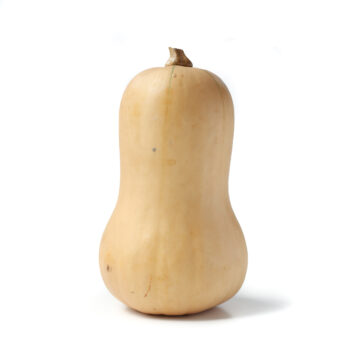
Cucurbita moschata. One of the most well-known and popular types of squash, winter squash is well-known for its amazing taste and smooth texture – it’s especially excellent in soups and roasted. Beige or buff in color, Butternut Squash is tall with an elongated neck and a bulbous bottom that houses its seeds. Size-wise, butternut is medium-sized, usually 3-5 pounds.
More about Butternut Squash
Carnival Squash
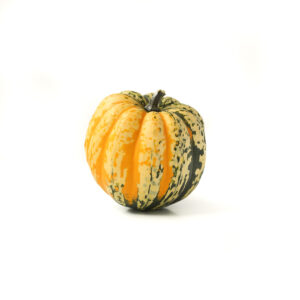
Cucurbita pepo. A hybrid created from Acorn Squash and Sweet Dumpling Squash, Carnival is a squash variety that features an Acorn-Squash-like shape with vertical orange and green mottled stripes on pale yellow skin. Carnival Squash is a small winter squash, usually around 1 pound. Its flesh is more on the fibrous side; nutty-tasting and sweet.
Chayote Squash

Cucurbita ficifolia. This petite, pale green Mexican squash is a summer squash with a unique feature: It has one big seed instead of a cavity full of them! There are a few varieties of Chayote Squash, but the most common looks a bit like a green, lumpy mango and tastes like a cross between a cucumber and a melon. The tough peel comes off with a vegetable peeler, and you can slice, dice, or julienne your Chayote Squash and sauté or stew – or simply enjoy raw. The seed is edible, too, but … doesn’t taste great.
More about Chayote Squash
- Recipe to try: Chayote Squash with Tomato and Green Chiles from Simply Recipes
Cinderella Pumpkin (aka Rouge Vif d’Etampes)

Cucurbita maxima. Winter squash. This medium-to-large sized pumpkin has a magical appearance – much like the pumpkin used in the fairytale to transform into Cinderella’s carriage. Cinderella Pumpkins are a French heirloom pumpkin, deep red-orange with smooth skin and a slightly flattened appearance. Its mild, sweet, and creamy flesh is on the watery side, so some choose to use it only for ornamental purposes. But others consider it to be great in pies and pumpkin bread.
Connecticut Field Pumpkin
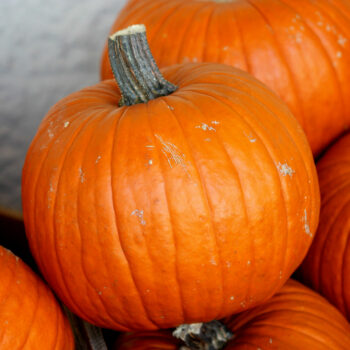
Cucurbita pepo. This heirloom pumpkin might exactly be what you picture when you hear the word “pumpkin.” It’s an heirloom pumpkin that’s traditional, classic, and ubiquitous. Connecticut Field Pumpkin is a large, bright orange, uniformly round pumpkin that clocks in at 15-25 pounds. Perfect for carving and while not the top choice for eating, it’s definitely edible. It tastes very mild and the texture is not as creamy as other pumpkin and winter squash varieties.
Cousa Squash
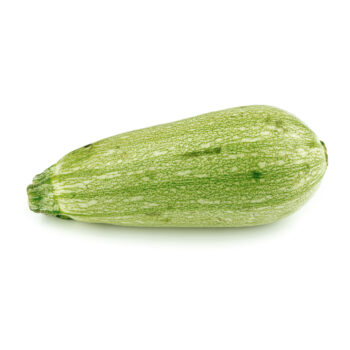
Cucurbita pepo. Also spelled “Kousa Squash,” This Middle Eastern summer squash is a type of zucchini with mild, nutty flavor and a wide, short shape. Cousa Squash is widely used in Lebanese cooking as a stuffed squash – the stem end is cut off and the entire squash is hollowed out, stem to stern, and stuffed with a meat and rice mixture then cooked in tomato sauce.
More about Cousa Squash
- Recipe to try: Lebanese Stuffed Kousa Squash from The Lemon Bowl
Crookneck Squash
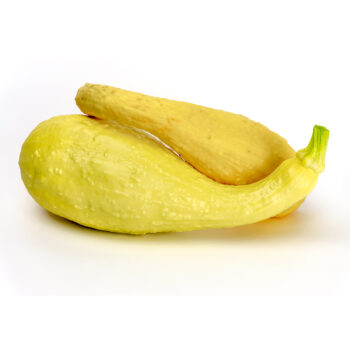
Cucurbita pepo (Crookneck Group). Also known as Crooknook Yellow Squash, this heirloom summer squash is essentially an earlier iteration of Yellow Squash (which has been bred to lose the crookneck and sport a more oblong, zucchini-like shape). Crookneck Squash is small to medium in size, oblong with a smaller, curved neck and yellow, bumpy skin. Its flesh is similar to zucchini, with a mild, black peppery taste. Best harvested (and eaten!) early – at about 6 inches in length.
More About Crookneck Squash
Cushaw Squash
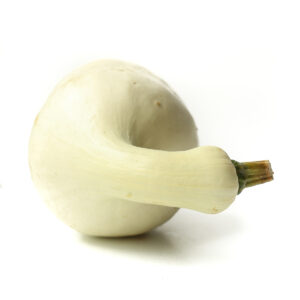
Cucurbita argyrosperma (Callicarpa Group). Also known as Cushaw Pumpkins, these winter squash are oblong-shaped with bulbous bottoms and an aggressively curved, crooked neck. They are medium to large in size, from seven pounds all the way up to 25 – that’s a big squash! They come in pure white, ivory, shades of green, or green and white stripes. The flesh is pale yellow and mild in flavor and is often used in pies.
Delicata Squash

Cucurbita pepo (Acorn Group). This popular winter squash is small in size, ranging from 1 to 2 pounds. It’s cylindrical in shape and its color is creamy white-to-yellow with green stripes from end to end. One of Delicata Squash’s claims to fame is that the skin is edible – to roast it, just cut it in half lengthwise, scoop out the seeds, slice, and roast, skin-on. Delicata Squash has a mildly sweet taste with a smooth texture. I think it tastes like a mild sweet potato!
More about Delicata Squash
Eight Ball Squash
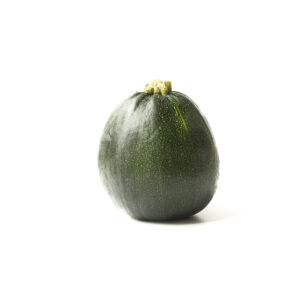
Cucurbita pepo (Zucchini Group). Also known as Eight Ball Zucchini, this summer squash is indeed a hybrid of zucchini – but in a compact ball shape! 8 Ball Squash are a popular option for stuffing – they taste like zucchini, but with their shape, they hollow out well and hold a lot of the good stuff. And yes, you can eat the skin – think of this as a uniquely shaped zucchini and you can treat it accordingly.
Flat White Boer Pumpkin
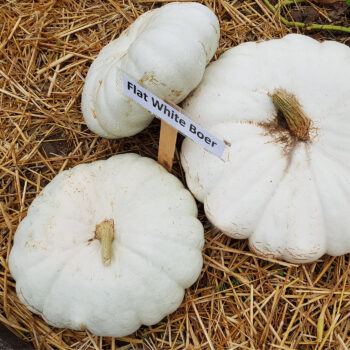
Cucurbita maxima. This large (10-30 pound), flat, white, gently ribbed pumpkin is gorgeous in displays (especially stacked towers!), but is excellent for eating as well. The orange flesh is very sweet and beloved in pies and baked goods.
More About Flat White Boer Pumpkin
Galeux d’Eysines Pumpkin
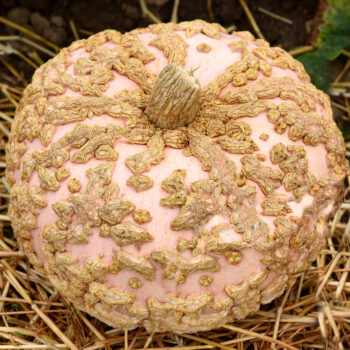
Cucurbita maxima. This unique French heirloom pumpkin features peachy-pink skin covered in warty, corky, peanut-like growths! This one is large – 10 to 20 pounds. If you’re looking for a unique ornamental pumpkin with loads of texture, this is it. But it’s excellent eating, too – the flesh is exceedingly sweet, perfect for pies and baking.
Grizzly Bear Pumpkin

Cucurbita pepo. True to its name, Grizzly Bear Pumpkin is brown and warty – just like its namesake! Okay, so maybe grizzlies aren’t warty – but the caramel hue of both the pumpkin and the bear set them apart. Medium to large in size, these 6-10 pound pumpkins are gorgeous for displays and sometimes used for carving too. This hard-shell pumpkin is grown more for its looks than for eating.
Gold Nugget Squash

Cucurbita maxima (Zapallito Group). This tiny round winter squash weighs in at 1-2 pounds each. The skin is deep orange with a green stripe around the stem. Gold Nugget Squash was originally bred to be grown as a substitute for sweet potato in colder climates where sweet potato can’t grow. Like sweet potatoes, Gold Nugget Squash has a starchy texture and sweet taste. Gold Nugget Squash is sometimes cooked whole (pierce the flesh first to allow steam to escape!) due to its hard rind. On the plus side, that hard rind makes it an excellent storer.
Golden Ace Acorn Squash

Cucurbita pepo (Acorn Group). Winter squash. There are a few gold Acorn Squashes, but I picked up this little cutie at a local farmer’s market and fell in love. Golden Ace Acorn Squash is a petite heirloom acorn squash, about two pounds. Its hue is golden-orange, with orange-yellow flesh that’s reportedly far more flavorful – mildly nutty, slightly sweet, pumpkiny – than your standard Acorn Squash.
Honeynut Squash
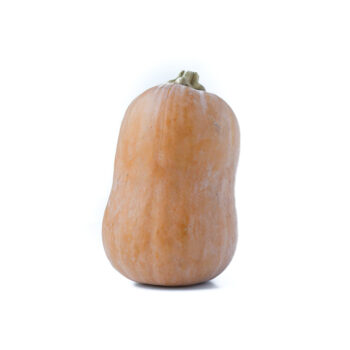
Cucurbita moschata. One of the new darlings of the squash world, Honeynut Squash is a butternut hybrid and indeed looks like a baby butternut with a deeper buff hue. These beautiful little winter squashes only grow to about 6 inches long and 1-2 pounds. The flesh is very sweet and creamy.
More about Honeynut Squash
- All About Honeynut Squash
- Recipe: Twice-Baked Honeynut Squash from Kitchen Treaty
Hubbard Squash
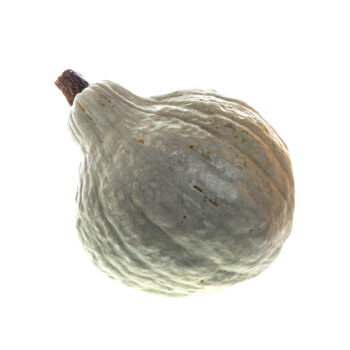
Cucurbita maxima (Hubbard group). This big blue behemoth might seem intimidating, but it’s worth the effort! Hubbard Squash is a blue-gray winter squash ranging in size from 5 to 40 (yes, 40!) pounds.
Its almost impossibly thick skin makes it a winter squash that can store for longer than almost any of them. But this means the skin is also very difficult to cut through – people try everything from cooking it whole in the oven for awhile first (not recommended) to breaking out the power tools! My favorite method comes from Heartbeet Kitchen’s Amanda Paa in her book Smitten with Squash (affiliate link) – she likes to crack it open with a hammer or wrap it in a garbage bag and drop it on the cement, then cut into smaller pieces, pre-bake at 300 degrees Fahrenheit for about 15 minutes, scrape off the peel and seeds, and THEN cut into chunks and proceed with cooking it. Also known as Blue Hubbard Squash.
Jack Be Little Pumpkin

Cucurbita pepo. These 3-inch wide, two-inch tall little cuties are perfect for displays! These mini pumpkins are usually grown for their ornamental value, but what many people don’t know is that they’re edible too. West Coast Seeds advises using sweet-tasting Jack Be Little pumpkins for edible soup bowls, fall soups, or slicing thin for tempura. Yum!
Jack O’ Lantern Pumpkin

Cucurbita pepo (Pumpkin Group). Jack O’ Lantern Pumpkins are bred for carving, not for eating. But that doesn’t mean you can’t eat them! Yes, you can eat Jack O’ Lantern Pumpkins (but please not after they’ve been carved, for food safety reasons). These winter squash are probably not going to be your top choice, though – the flesh is typically stringier and not as sweet as Sugar Pie Pumpkins.
Jarrahdale Pumpkin

Cucurbita maxima. Winter squash. This medium-to-large gray-blue heirloom pumpkin weighs in at around 6-10 pounds but can be grown up to 20 pounds. This beautiful Australiam pumpkin sports a flattened, classic pumpkin shape, which makes it a popular choice for ornamental displays. Its deep orange flesh has a rich, sweet flavor.
More About Jarrahdale Pumpkin
Jester Squash
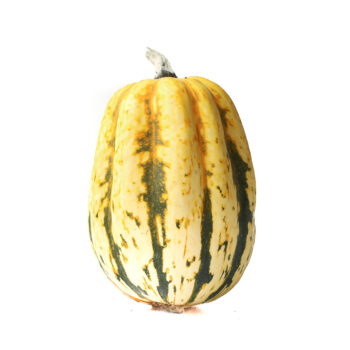
Cucurbita pepo. This small winter squash – weighing in at just 1-1.5 pounds – is a rounder, more squat variation of Delicata. Jester Squash are oval-shaped, ivory with green striped ribs and a few yellow speckles here and there.
It is considered to be one of the best-flavored squash, with sweet and mild flesh and a skin that is tender enough that you don’t have to peel it off if you don’t want to. Preparations include slicing into rings skin-on and roasting, or roasting the halves a’la Acorn Squash.
Kabocha Squash

Cucurbita maxima. This Japanese squash is a popular winter squash, small-to-medium in size (1.5 – 5 pounds) with a slightly flattened round shape. The rind is a beautiful deep green; inside you’ll find sweet, yellow-orange, nutty flesh with a light, fluffy, dry texture. Kabocha is also known as Japanese Pumpkin. There are many varieties of Kabocha Squash including Blue Kuri and Red Kabocha.
Kakai Pumpkin

Cucurbita pepo. Winter squash. Medium in size at five to eight pounds, Kakai Pumpkins are a beautiful Japanese pumpkin with green and orange mottled markings and raised ribs. A beautiful pumpkin to display, but what’s really cool about Kakai Pumpkins are the seeds! Kakai Pumpkins are known and grown for their hull-less seeds – think the green pepitas you see in the store. The flesh is considered rather tasteless – get this one for its looks and those wonderful seeds.
Long Island Cheese Pumpkin

Cucurbita moschata (Cheese Pumpkin Group). Winter squash. This buff-colored, medium-to-large, 6-10 pound pumpkin gets its name from its shape, which resembles a wheel of cheese! This U.S. East Coast heirloom reportedly almost went extinct in the mid-1900s but was brought back to life by a dedicated farmer. With its mild, sweet, fine-grained flesh, Long Island Cheese Pumpkin is a popular choice for pies.
More about Long Island Cheese Pumpkin
- Long Island Cheese Pumpkin: Pics, Cooking, Nutrition, & More
- Recipe to try: Long Island Cheese Pumpkin Soup by Out East Foodie
Lumina Pumpkin
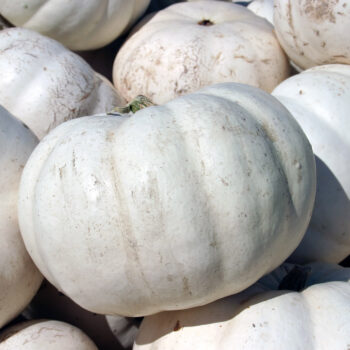
Cucurbita maxima. Lumina Pumpkins are so pretty, flaunting white skin that sometimes skews ever so slightly blue-green. A large pumpkin, it weighs in at 10-15 pounds and is about the size of a volleyball. Luminas are great for carving (ghost-o-lantern, anyone?!) and painting, but they’re also delicious eating. Lumina’s yellow flesh is sweet and is especially good in soup.
Marina Di Chioggia Squash

Cucurbita maxima (Turban group). Also known as Marina Di Chioggia Pumpkin, this unique, warty blue-green squash is an Italian favorite. Medium in size, from 5-10 pounds, this interesting winter squash is named for the Marina Di Chioggia fishing port near Venice, Italy. They add texture and color to ornamental displays, but are delicious to eat too. The flesh is sweet, rich, and meaty and is often used in pumpkin ravioli and gnocchi.
Musquee de Provence Pumpkin

Cucurbita moschata. Musquee De Provence Pumpkin is a large, flat pumpkin with vast lobes and deep ribs. Its unique and beautiful coloring features a musky orange with dotted splotches of true green. Weighing in at an average of 20 pounds each (but sometimes up to 40!), this heirloom is a big one! Musquee De Provence originated in southern France, where one can often find wedges of the pumpkin for sale at farmer’s markets to take home for cooking. The deep orange flesh is known for being excellent tasting, with a sweet, mild, and very nutty flavor. Otherwise known as Cinderella Pumpkin.
Naples Long Squash
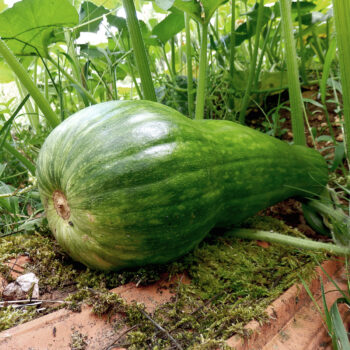
Cucurbita moschata. Naples Long Squash is one huge squash! Weighing in from 20 to 50 pounds (yep!) this winter squash has a deep green skin, deep orange interior, and is considered to be sweet and rich in flavor.
One Too Many Pumpkin
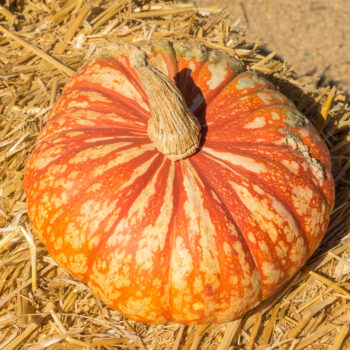
Cucurbita maxima. One Too Many Pumpkin is a medium to large pumpkin with a unique look. Some say the white flesh with reddish-orange “veining” – and perfectly round shape – looks like a giant bloodshot eyeball. Gross, but perfect for Halloween time! Generally considered an ornamental pumpkin, its yellow-orange flesh is also edible and said to be delicious in pies.
Pattypan Squash
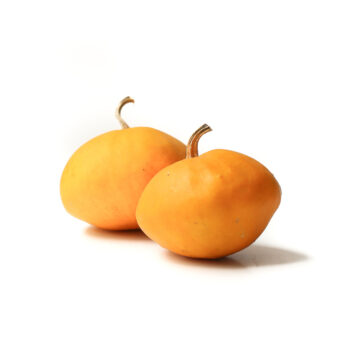
Cucurbita pepo (Scallop Group). Also known as Flying Saucer Squash thanks to its flat, wide, UFO-like shape, this round summer squash, with its scalloped edges, is one of the more unique-looking kinds of squash. Pattypan is best harvested and eaten when still small in size. Pattypan Squash come in several varieties and colors can be white, yellow, orange, or green. Taste-wise, Pattypan Squash are similar to summer squash and zucchini, buttery and a bit sweeter. Pattypan Squash is delicious sautéed or grilled.
More About Pattypan Squash
- Patty Pan Squash Guide
- Recipe to try: Pattypan Squash Panzanella from Love & Lemons
Porcelain Doll Pumpkin
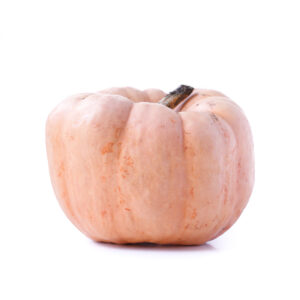
Cucurbita pepo. Winter squash. This large, uniquely pink pumpkin is a favorite for ornamental displays and makes for delicious eating, too. Blocky, round, and deeply ribbed, Porcelain Doll is quite large, from 15-20 pounds in size. Its sweet-tasting flesh is popular in soups and pies.
It may look like an heirloom, but Porcelain Doll Pumpkin is actually a fairly new hybrid developed by Colorado Seeds, who set up the non-profit Pink Pumpkin Patch Foundation – a portion of seed proceeds go to breast cancer research.
Queensland Blue Pumpkin

Cucurbita pepo. This blocky blue, medium-to-large pumpkin is similar to Jarrahdale, but a bit more petite and squared off. An Australian pumpkin, first imported to US in 1932. A lovely addition to fall displays, but excellent eating too (with a super long shelf life!) Flesh is vibrant orange and very sweet tasting.
Red Kabocha Squash

Cucurbita maxima. Winter squash. Japanese in origin. So similar to Red Kuri that they were both in the same display at my local market under that label. But Red Kabocha are flatter more squat types of squash, whereas Red Kuri sport more of a teardrop/onion shape. Red Kabocha are small (2-3 pounds) and taste smooth, creamy, sweet and nutty. Also known as Amber Cup Squash.
Red Kuri Squash

Cucurbita maxima. Winter squash. This petite teardrop-shaped stunner with bright red-orange skin is a relative of the Hubbard. Also known as Uchiki Kuri Squash, Red Kuri comes in a manageable small size, usually 3-4 pounds. Inside, Red Kuri Squash features golden yellow flesh which, when cooked, is smooth and tender in texture, and sweet and nutty in taste.
More about Red Kuri Squash
- Recipe to try: Roasted Red Kuri Squash with Tahini Sauce and Kale by Heartbeet Kitchen
Red Warty Thing Pumpkin
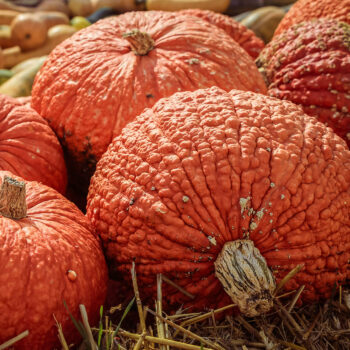
Cucurbita maxima. With its literal name, Red Warty Thing is indeed as red as it is warty. That bumpy skin gives it an advantage (other than good looks) – that thick skin helps it keep in storage for months. Red Warty Thing is a large pumpkin, weighing 10-20 pounds. Thought to be a cross between American Turban Squash and Hubbard Squash, its vibrant orange flesh is edible – smooth, mild, and sweet.
Silver-Edged Pumpkin

Cucurbita argyrosperma (Silverseed Group). Winter squash. This green striped pumpkin is a Mexican heirloom, grown for its ornamental beauty and its huge seeds – white with a silver edge (hence the name!) Small to medium in size, this unique heirloom’s seeds are delicious hulled and roasted or ground into pipian sauce, a traditional Mexican sauce made with pureed greens and pumpkin seeds.
Spaghetti Squash

Cucurbita pepo (Vegetable Marrow Group). Winter squash. Oblong, yellow, medium-sized Spaghetti Squash is a squash unto itself! No other types of squash feature that unique flesh that separates into angel-hair-pasta-like strands. Prized more for its texture than its flavor, which is mild and slightly nutty but takes on the flavors of what it’s mixed with (in my opinion, there’s nothing better than cooked spaghetti squash strands tossed with butter, parmesan, sea salt, and copious amounts of black pepper!)
More about Spaghetti Squash
Speckled Hound Pumpkin

Cucurbita maxima. This medium-in-size pumpkin grows to 4-6 pounds and features a round, slightly flattened shape and beautiful dusky orange lobes with deep ribs and greenish-blue stripes. Its pale orange flesh is dry and sweet. A descendant of Kabocha Squash, it’s also known as Speckled Hound Squash.
Starry Night Squash

Cucurbita pepo (Acorn Group). Winter squash. This new variety of Acorn Squash is slightly smaller than acorn, with yellow-speckled green skin. The fruit is very nutty with balanced sweetness and has a smoother, less stringy texture than acorn squash. When roasted, Starry Night Squash caramelizes wonderfully.
Stripetti Squash
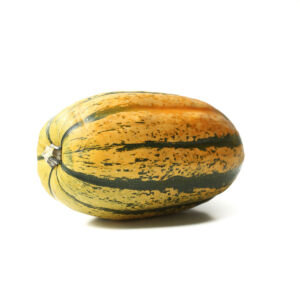
Cucurbita pepo (Vegetable Marrow Group). Winter squash. This hybrid crosses two types of squash – Spaghetti Squash and Delicata – for sweet and nutty spaghetti-squash-like strands in a beautifully striped exterior. Medium in size, Stripetti weighs in at 4-5 pounds. Stripetti is a newer hybrid squash, developed around 2010 in Colorado.
Sugar Pie Pumpkin

Cucurbita pepo (Pumpkin Group). Winter squash. This small-to-medium pumpkin (usually 3-6 pounds) is a fall staple, available in grocery stores just about everywhere. Which is a great thing for pie bakers! This perfectly round, perfectly orange, perfectly uniform pumpkin is, well, perfect! Excellent in pies but also delicious in more savory applications like pumpkin soup. Sweet flavor with a stringless texture. Also known as Sugar Pumpkin and New England Pumpkin.
Swan White Acorn Squash
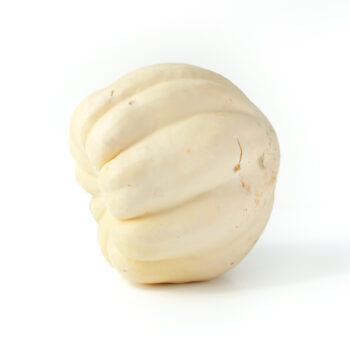
Cucurbita pepo (Acorn Group). This pretty ivory winter squash is small to medium in size, with a creamy white rind and surprisingly pale yellow flesh – much different than the deep orange you see in most winter squashes. Swan White Acorn Squash has a smooth texture with a mildly sweet, nutty, peppery flavor. In fact, it’s also known as Pepper Squash!
Sweet Dumpling Squash
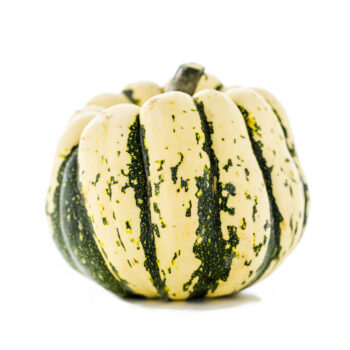
Cucurbita pepo (Acorn Group). Winter squash. This small (approx. 1 pound), creamy yellow squash is one of the prettiest types of squash, with mottled dark green stripes along vertical ribs in a cute mini acorn shape. Because they are difficult to peel, Sweet Dumpling Squash are often roasted with their skin on. Creamy, dry, and smooth-textured, with sweet, relatively mild, and nutty flavor.
Sweet Meat Squash

Cucurbita maxima. This heirloom blue-green squash originated in the mid-1900s in Portland, Oregon. Weighing in at 10-20 pounds, this one’s a big squash – good thing, because it’s great eating, too. The deep yellow flesh is sweet, dry, and fine, similar to a sweet potato. This type of winter squash is said to make some of the best pumpkin pie around!
Tahitian Butternut Squash
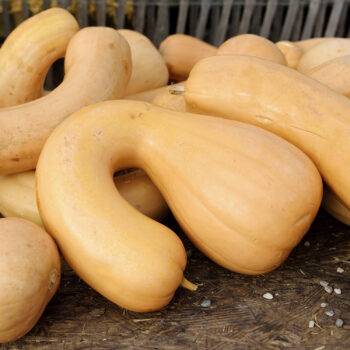
Cucurbita moschata. Winter squash. Tahitian Butternut Squash looks like a very overgrown Butternut Squash! Ranging in size from 8-40 pounds, this large squash features a buff rind and bulbous bottom like its relative, but has a long, curved neck. Its flesh is a paler orange, sometimes yellow in color. It’s sought out because it stores for a long time and has dense flesh with a rich and sweet flavor. Tahitian Butternut is a rare heirloom, thought to have originated in Bora Bora. Also known as Tahitian Squash and Tahitian Melon Squash.
Triamble Squash

Cucurbita Maxima. One of the most unique types of squash! Also known as Shamrock Squash, this blue-green beauty is an Australian heirloom. Three distinct lobes – each filled with seeds – give Triamble its shamrock-like looks, and it certainly is an ornamental beauty. Also known as Triamble Pumpkin.
Tromboncino Squash

Cucurbita moschata. This summer squash has a bulbous end and a long, swan-like neck. Pale green in color.
Turks Turban Squash

Cucurbita maxima (Turban group). This fanciful orange-and-olive-green striped squash resembles – you guessed it – a turban. Medium in size, weighing in at 5-7 pounds, this heirloom winter squash is beautiful for ornamental uses but also considered quite good tasting as well, with a mildly sweet, nutty, flavor that’s similar to pumpkin. Also known as Turban Squash, French Turban, Turk’s Cap, and Turk’s Head.
White (Ghost) Pumpkin
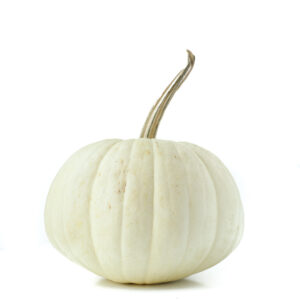
Cucurbita pepo (Pumpkin Group). Winter squash. A popular pumpkin for fall displays and Jack O’ Lanterns that go “boo,” White (Ghost) Pumpkins are pretty great for eating, too. There are actually several varieties of white pumpkins, with flesh ranging from pale cream to orange and sizes ranging from small to large. Taste is similar to their orange relatives. Also known as Pumpkins Lumina and Ash Gourd.
More about White (Ghost) Pumpkins
Recipe to try: Savory Stuffed Pumpkin with Sausage and Gruyere from The Kitchn
Winter Luxury Pumpkin
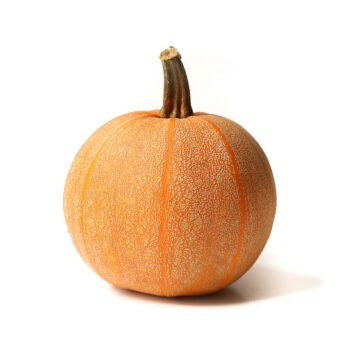
Cucurbita pepo (Pumpkin Group). Winter squash. Quite possibly the ultimate darling of the pie pumpkin world, this uniformly round orange pumpkin features wide stripes of lacy, cork-like netting on its rind. Weighing in at around 4-5 pounds each, Winter Luxury Pumpkin falls firmly into the “medium” category, but there’s nothing average about this one. It’s revered far and wide for its superior taste that’s sweet, dense, velvety smooth, and sweet with true old-fashioned pumpkin flavor. Truly does make for a superior pumpkin pie! Also known as Winter Luxury Pie Pumpkin, Winter Luxury Squash, and Livingston’s Pie Squash.
More about Winter Luxury Pumpkin
Yellow Squash
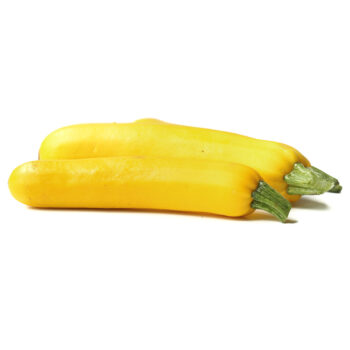
Cucurbita pepo. Yellow Squash are descended from Crookneck Squash; the warts and crookneck have been bred out of them for a straight, smooth, bright yellow appearance about the size of a zucchini (as long as it is picked in time – they can get giant just like a neglected garden zucchini can! Very mild in flavor; takes on the flavors of whatever it’s cooked with, similar to zucchini. Also known as Summer Squash (not to be confused with the category of the same name) and Yellow Zucchini.
More about Yellow Squash
- Recipes to try: Slow Cooker Smoky White Bean & Summer Squash Soup from Kitchen Treaty; Summer Squash Gratin with Salsa Verde from Smitten Kitchen
Yokohama Squash
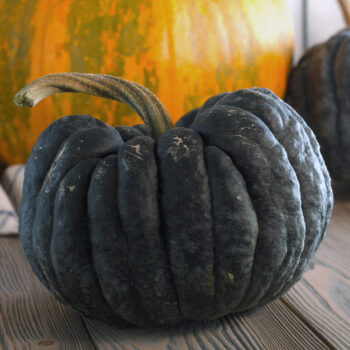
Cucurbita moschata (Japonica Group). Winter squash. Also known as Yokohama Pumpkin, Yokohama Squash is a Japanese heirloom with a dark grey-green – almost black – hue. Inside, Yokohama blazes dark orange, with fine-grained, smooth flesh and unique, surprisingly sophisticated flavor described as mild yet reminiscent of tropical fruits. Medium (3-4 pounds) in size.
Zephyr Squash
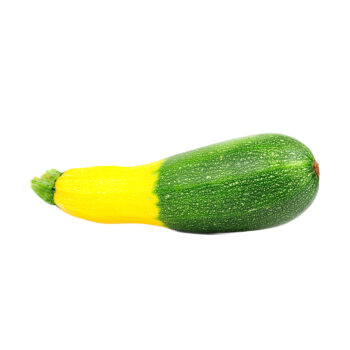
Cucurbita pepo. This unique summer squash looks like half a yellow squash and half a zucchini. It’s like the mermaid of the squash world (a ridiculous thing to say, I know, but I can’t help myself)! This hybrid was created in the late 90s, a cross between a yellow crookneck squash and a hybrid squash that descended from Acorn & Delicata. Pick when young – 4-6 inches in length or so – for best flavor (though still delicious when larger). Cylindrical in shape, yellow on the stem end and green on the blossom end, with creamy white flesh that’s mildly sweet and nutty.
Zucchini

Cucurbita pepo (Zucchini Group). The most popular squash of all! Zucchini is beloved for its versatility and grow-ability – there’s a reason why “Sneak a Zucchini On Your Neighbor’s Porch” Day is a thing (August 8, if you’re wondering!)
Green in color with a uniform, cylinder shape, zucchini is a summer squash that is considered to be the very best-tasting when harvested at around 6 inches long – but that also depends on the variety (and there are dozens of varieties!)
Excellent sliced thin and baked into chips, stuffed and made into “zucchini boats,” sliced and fried, sautéed, shredded into baked goods … seriously endless possibilities. Also known as Green Zucchini Squash.
More Zucchini
- Recipe: Stuffed Zucchini
- Growing Zucchini (and Summer Squash) from Growfully
Sources
Most scientific names sourced from:
Goldman, Amy (2004). The Compleat Squash: A Passionate Grower’s Guide to Pumpkins, Squashes, and Gourds. Workman Publishing.



Hello! Loved this but still trying to find the name of a squash that popped up in my manure and compost pile! Looks like a delicate, but round and larger. About 2 lbs if not more. Jesters are smaller…. Saving seeds!
Hi Linda! Those mystery squashes can be tough to identify! Could it be a carnival squash or a stripetti (a cross between delicata and spaghetti squash)? It could also be that it’s the result of cross-pollination (therefore might not be edible).
Karen, Love this work you’ve done! The pictures helped me identify some mystery squashes. If you have the time a good addition to each entry would be harvest timing, storage time, and when at peak flavor. Best, Dale
Hi Dale! I’m so glad it was helpful. Thank you so much for the idea to add harvest, storage, and peak flavor info. Great idea! Added to my list. 🙂
Amazing thank you!
Does a hardcover of this exist??
It would be super useful to keep among the other kitchen books!
It does not, but it would be very useful wouldn’t it?! Maybe someday 🙂
Georgia candyroaster definately worth mentioning! very productive plants and huge squashed! suepr sweet when roasted, skin is thin when roasted.
Yes! I do have that lumped in with Banana Squash as another name it goes by, would you say that’s accurate? I’ll do some more research! Thank you Maryam!